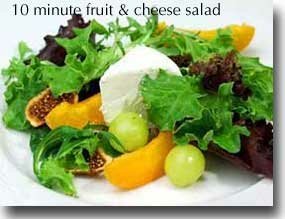August 8, 2013
Check Out What's New On Our Website
Foods
rich in chromium can help maintain normal blood sugar and insulin
levels as well as support normal cholesterol levels. Find out more about
Chromium.
Today's Recipe
If you don't know what to serve for dinner tonight ...
This health-promoting salad offers you a quick-and-easy way to enjoy
the delicious combination of fruit and cheese as part of your Healthiest
Way of Eating.
10-Minute Fruit & Cheese Salad

Prep and Cook Time: 10 minutes
Ingredients:
- 1/4 cup green seedless grapes
- 3 fresh (or dried) apricots, cut into eighths
- 3 dried figs, sliced medium thick
- 1/2 lb mixed salad greens
- 2 TBS fresh lemon juice
- salt and cracked black pepper to taste
- extra virgin olive oil to taste
- 3 oz goat or gorgonzola cheese
- optional: 1/4 lb sliced, precooked turkey breast, cut into bite-size pieces
- Toss all ingredients, except cheese, together. Top with goat or gorgonzola cheese.
In-Depth Nutritional Profile for 10-Minute Fruit & Cheese Salad
Healthy Food Tip
Can you tell me about the phenols in extra virgin olive oil?
Why is it so important to use 100% extra virgin olive oil? The reason lies in this oil's unique phenol content. Extra virgin olive oil-oil made from the first pressing of the olives-contains the phenols protocatechuic acid, oleuropein, tyrosol, hydrotyrosol, dihydroxyphenylethanol, and other unique phenyl-ethyl alcohols as well as lignans and secoiridoids. (Lignans may already be familiar to you from your reading about flaxseeds. However, it is also important to know that certain lignans-including pinoresinol and acetoxypinoresinol-are key phenol components found in extra virgin olive oil.) These phenols are most concentrated in the first pressing of olives, which make extra virgin olive oil. Subsequent pressings-even those that produce virgin olive oil-do not contain the same concentrations of these unique phenols.
The high phenol concentration in extra virgin olive oil results in three key health benefits. First is the ability of this rich phenol mixture to help protect olive oil's vitamin E. Especially during the process of heating-and even at low heating temperatures-these phenols help to stabilize the vitamin E present in extra virgin olive oil. Second is the ability of this phenol mixture to engage in free radical scavenging. Especially when it comes to the neutralization of free radicals like hydroxyl radical and superoxide anion radical, the rich phenol mixture in extra virgin olive oil is especially important. In fact, research studies have confirmed the ability of extra virgin olive oil's phenols to help protect against free radical damage to LDL cholesterol as well as cellular DNA.
Reduction of inflammatory activity is a third area of potential benefit when it comes to the rich phenol mixture in extra virgin olive oil. Studies in this area have compared extra virgin oil to olive oil from later pressings, and the results show that extra virgin olive oil is able to lower certain markers of inflammation (called TXB2 and LTB2) during a window of time 2-6 hours after consumption of the extra virgin oil where olive oil from later pressings is unable to do so.


No comments:
Post a Comment